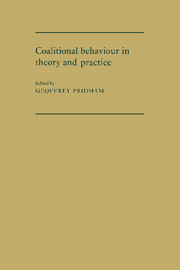Book contents
- Frontmatter
- Contents
- List of illustrations
- List of tables
- Notes on the contributors
- Preface
- 1 An inductive theoretical framework for coalitional behaviour: political parties in multi-dimensional perspective in Western Europe
- 2 Between theoretical elegance and political reality: deductive models and cabinet coalitions in Europe
- 3 Changing coalitional preferences among West German parties
- 4 The FDP and coalitional behaviour in the Federal Republic of Germany: multi-dimensional perspectives on the role of a pivotal party
- 5 Cabinet stability in the French Fourth Republic: the Ramadier coalition government of 1947
- 6 Coalition formation and maintenance in Belgium: a case-study of elite behaviour and changing cleavage structure, 1965–1981
- 7 The Dutch Christian Democratic party and coalitional behaviour in the Netherlands: a pivotal party in the face of depillarisation
- 8 Coalition or Fianna Fail? The politics of inter-party government in Ireland
- 9 Italy's party democracy and coalitional behaviour: a case-study in multi-dimensionality
- 10 Party coalitions in the first democratic period in Spain, 1977–1982
- 11 Coalitional theory and practice in Scandinavia
- 12 Multi-dimensional approaches to the study of local coalitions: some cross-national comparisons
- 13 Research notes
- Index
13 - Research notes
Published online by Cambridge University Press: 05 November 2011
- Frontmatter
- Contents
- List of illustrations
- List of tables
- Notes on the contributors
- Preface
- 1 An inductive theoretical framework for coalitional behaviour: political parties in multi-dimensional perspective in Western Europe
- 2 Between theoretical elegance and political reality: deductive models and cabinet coalitions in Europe
- 3 Changing coalitional preferences among West German parties
- 4 The FDP and coalitional behaviour in the Federal Republic of Germany: multi-dimensional perspectives on the role of a pivotal party
- 5 Cabinet stability in the French Fourth Republic: the Ramadier coalition government of 1947
- 6 Coalition formation and maintenance in Belgium: a case-study of elite behaviour and changing cleavage structure, 1965–1981
- 7 The Dutch Christian Democratic party and coalitional behaviour in the Netherlands: a pivotal party in the face of depillarisation
- 8 Coalition or Fianna Fail? The politics of inter-party government in Ireland
- 9 Italy's party democracy and coalitional behaviour: a case-study in multi-dimensionality
- 10 Party coalitions in the first democratic period in Spain, 1977–1982
- 11 Coalitional theory and practice in Scandinavia
- 12 Multi-dimensional approaches to the study of local coalitions: some cross-national comparisons
- 13 Research notes
- Index
Summary
A note on the empirical analysis of coalition policy
Formal theories of government coalition formation tend to consider two inputs: the number of seats controlled by a party and its position in the ideological party space. Formal theories of government coalition payoff tend to consider two outputs: the distribution of cabinet portfolios and the policy package agreed by coalition partners. The testing of such theories has been straightforward with respect to seat and portfolio distributions, which are easily ascertainable. The policy positions of both parties and coalitions, however, have presented empirical problems. Until recently, the solution has been to have recourse to experts, who have been asked to locate parties on ideological dimensions. These expert judgements have then been used as input to the analysis. (A recent, and systematic, exposition of this technique can be found in Castle and Mair (1984).)
‘Expert’-generated data have severe drawbacks as far as the testing of coalition theories is concerned. By far the most serious of these is that data on party policy positions must be entirely independent of the subsequent coalition negotiations, if such data are to be used to predict coalition formation. In practice it seems likely that expert judgements on policy positions will be highly coloured by the outcome of coalition politics. However much they might be earnestly exhorted to do so, any set of experts would find it very difficult to divorce the fact that two parties went into government together from the possibility, in theory, that they might be moving further apart in policy terms.
- Type
- Chapter
- Information
- Coalitional Behaviour in Theory and PracticeAn Inductive Model for Western Europe, pp. 296 - 305Publisher: Cambridge University PressPrint publication year: 1986

